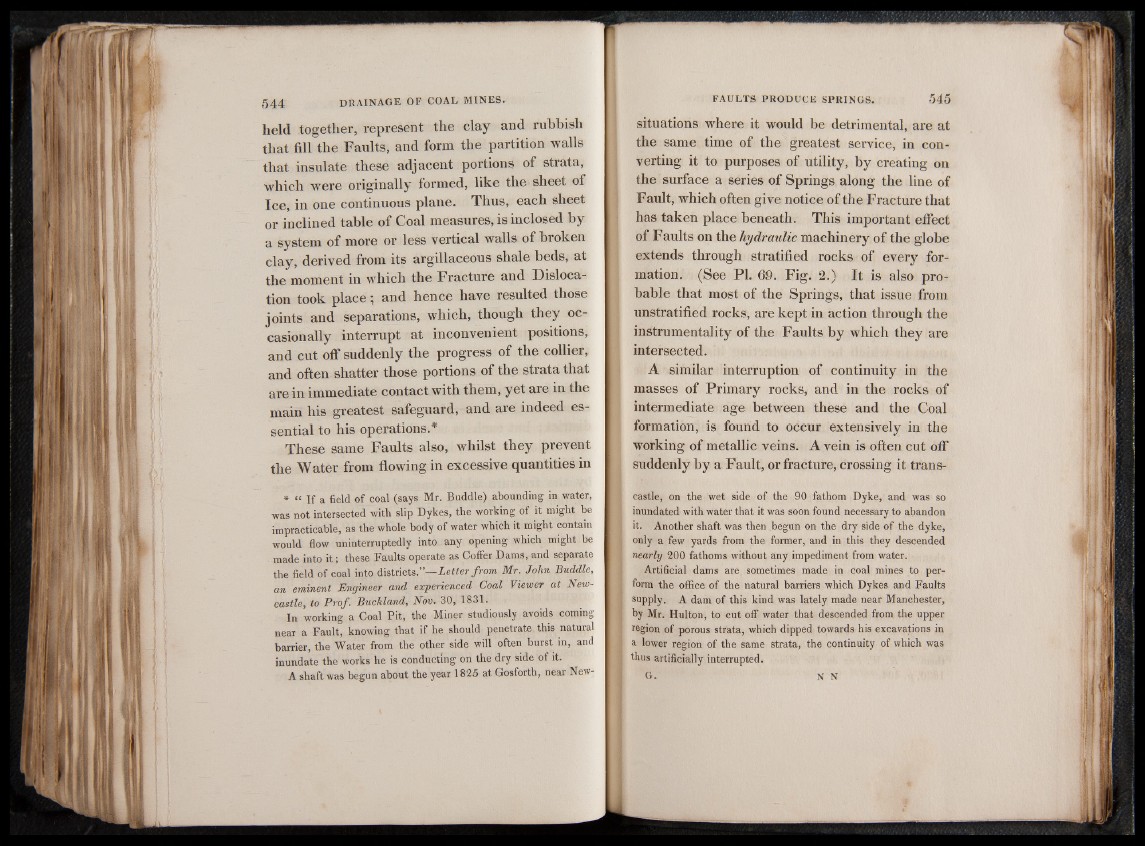
held together, represent the clay and rubbish
that fill the Faults, and form the partition walls
that insulate these adjacent portions of strata,
which were originally formed, like the sheet of
Ice, in one continuous plane. Thus, each sheet
or inclined table of Coal measures, is inclosed by
a system of more or less vertical walls of broken
clay, derived from its argillaceous shale beds, at
the moment in which the Fracture and Dislocation
took place; and hence have resulted those
joints and separations, which, though they occasionally
interrupt at inconvenient positions,
and cut off suddenly the progress of the collier,
and often shatter those portions of the strata that
are in immediate contact with them, yet are in the
main his greatest safeguard, and are indeed essential
to his operations.*
These same Faults also, whilst they prevent
the Water from flowing in excessive quantities in
* « If a field of coal (says Mr. Buddie) abounding in water,
was not intersected with slip Dykes, the working of it might be
impracticable, as the whole body of water which it might contain
would flow uninterruptedly into any opening which might be
made into i t ; these Faults operate as Coffer Dams, and separate
the field of coal into districts.”—Letter from Mr. John Buddie,
an eminent Engineer and experienced Coal Viewer at Newcastle,
to Prof. Buckland, Nov. 30, 1831.
In working a Coal Pit, the Miner studiously avoids coming
near a Fault, knowing that if he should penetrate this natural
barrier, the Water from the other side will often burst in, and
inundate the works he is conducting on the dry side of it.
A shaft was begun about the year 1825 at Gosforth, near Newsituations
where it would be detrimental, are at
the same time of the greatest service, in converting
it to purposes of utility, by creating on
the surface a series of Springs along the line of
Fault, which often give notice of the Fracture that
has taken place beneath. This important effect
of Faults on the hydraulic machinery of the globe
extends through stratified rocks of every formation.
(See PI. 69. Fig. 2.) It is also probable
that most of the Springs, that issue from
unstratified rocks, are kept in action through the
instrumentality of the Faults by which they are
intersected.
A similar interruption of continuity in the
masses of Primary rocks, and in the rocks of
intermediate age between these and the Coal
formation, is found to occur extensively in the
working of metallic veins. A vein is often cut off
suddenly by a Fault, or fracture, crossing it transcastle,
on the wet side of the 90 fathom Dyke, and was so
inundated with water that it was soon found necessary to abandon
it. Another shaft was then begun on the dry side of the dyke,
only a few yards from the former, and in this they descended
nearly 200 fathoms without any impediment from water.
Artificial dams are sometimes made in coal mines to perform
the office of the natural barriers which Dykes and Faults
supply. A dam of this kind was lately made near Manchester,
by Mr. Hulton, to cut off water that descended from the upper
region of porous strata, which dipped towards his excavations in
a lower region of the same strata, the continuity of which was
thus artificially interrupted.